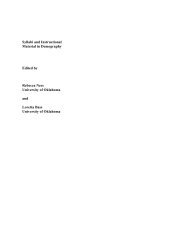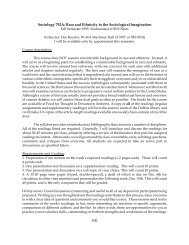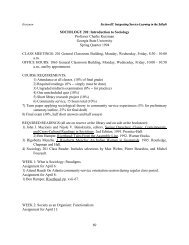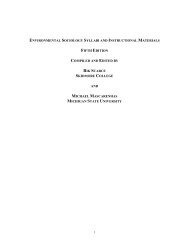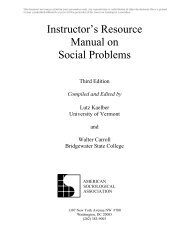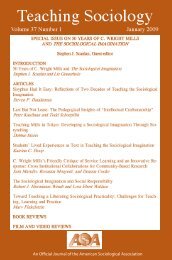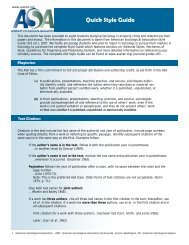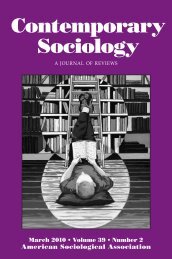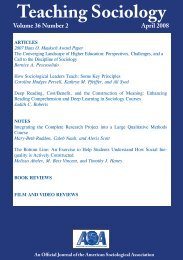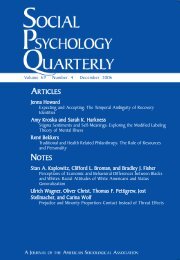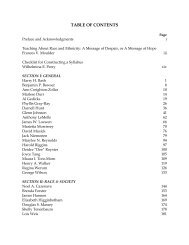SOCIOLOGY EDUCATION - American Sociological Association
SOCIOLOGY EDUCATION - American Sociological Association
SOCIOLOGY EDUCATION - American Sociological Association
Create successful ePaper yourself
Turn your PDF publications into a flip-book with our unique Google optimized e-Paper software.
Gender, Obesity, and Education 255<br />
Table 4. Results from Poisson Regressions Predicting Wave II Self-Medication and Academic<br />
Disengagement Among Girls (n = 4,865)<br />
ic risk factor that is on par with other demographic,<br />
behavioral, and cognitive factors<br />
that have received so much attention. This<br />
risk status of obesity touches on one of the<br />
fundamental tenets of contemporary sociological<br />
research on education, namely, that<br />
the youth culture that emerges within the<br />
educational system filters into the formal<br />
processes of schools in ways that shape academic<br />
outcomes (Coleman 1961; Eder et al.<br />
1995).<br />
To elucidate the ways in which the social<br />
side of schooling creates academic consequences<br />
out of nonacademic personal circumstances,<br />
I returned to two core traditions<br />
of 20th-century sociology. Integrating<br />
insights from Cooley’s ([1902]1983) looking-<br />
Exponentiated Coefficients Exponentiated Coefficients<br />
for Self-Medication for Disengagement<br />
Alcohol Marijuana<br />
Variable Use Use Failures Truancy<br />
Obesity 1.13+ 1.17+ 1.24** 1.04<br />
Selection Factors<br />
Grade level 1.05** .93* .79*** 1.40***<br />
Non-Latino/Latina white a — — — —<br />
African <strong>American</strong> .83* .80* 1.08 .84*<br />
Latino/Latina 1.12 1.21* 1.10 .98<br />
Asian <strong>American</strong> .86 .99 .95 1.12<br />
Other race/ethnicity .95 1.22 .99 1.16<br />
Family structure (two parent) .98 .84** .89* .78***<br />
Parental education .99 .99 .90*** .90***<br />
School level (middle) 1.04 .90 1.24* 1.22***<br />
School sector (private) .90 .90 .55** .85<br />
School minority representation .99 .99 1.01 .99<br />
School proportion of<br />
college-educated parents 1.17 1.08 .57 .86<br />
Measured ability .99 1.01 .99*** .99***<br />
Athletic status 1.10* 1.03 .89* .81***<br />
Number of friends .99 1.02 .99 1.01<br />
Involvement with friends 1.12*** 1.08** .97 1.10***<br />
Romantic involvement 1.28*** 1.54*** .93 1.23***<br />
Wave I version of outcome 1.45*** 1.39*** 1.60*** 1.42***<br />
School Factors<br />
Proportion of obese girls .90 3.06 1.21 .46<br />
Proportion of obese boys 1.52 .51 .26 13.07<br />
a White was the comparison category for the race/ethnicity dummy variables.<br />
*** p < .001, ** p < .01, * p < .05, + p < .10.<br />
glass self and Goffman’s (1963) social stigma<br />
perspectives, as well as their descendants, my<br />
conceptual model asserted that the stigma<br />
attached to obesity in <strong>American</strong> culture creates<br />
a climate of negative social feedback,<br />
either real or perceived, for obese youths,<br />
especially when that larger social stigma is<br />
echoed and reinforced in the peer cultures of<br />
the youths’ schools. Such feedback, in turn,<br />
can trigger problematic psychosocial responses<br />
as obese youths try to escape this stigma,<br />
alleviate the stress associated with it, or simply<br />
accept it as legitimate. Because psychosocial<br />
adjustment cannot be divorced from academic<br />
progress, these responses to the stigma<br />
of obesity disrupt the educational attainment<br />
of obese youths. Considering that edu-



